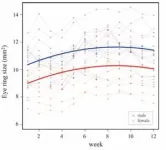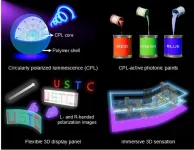(Press-News.org) In a study of different types of distraction involving more than 1,000 participants, researchers statistically derived a novel measure—dubbed the “d factor”—that could represent a person’s general tendency towards distraction and may be linked with attention-deficit/hyperactivity disorder (ADHD). Han Zhang of the University of Michigan, Ann Arbor, and colleagues present these findings in the open-access journal PLOS ONE on October 25, 2023.
Prior research has explored various types of distraction, such as external stimulations, repetitive negative thinking, or daydreaming. Some research has suggested that vulnerability to different types of distraction could potentially be mathematically captured by an overarching “distractibility factor.” However, the evidence for a distractibility factor has been limited, and most studies have not considered a comprehensive collection of different types of distraction—including some associated with ADHD.
To better understand different types of distraction and their potential relationship with ADHD, Zhang and colleagues asked a total of 1,220 participants to complete an extensive series of questionnaires to evaluate their tendency to experience different kinds of distraction in their daily lives, such as difficulty concentrating with a TV on or losing oneself in daydreaming. The questionnaires also evaluated symptoms of ADHD and hyperfocus—a long-lasting state of intense concentration sometimes linked to ADHD.
Analysis of participants’ answers surfaced three key, distinct factors that could statistically explain patterns observed in the data: external distraction, unwanted intrusive thoughts, and mind-wandering. The researchers found that the statistical relationships between these three factors could be accounted for by a single, higher-level factor—which they named the d factor.
Further analysis showed strong statistical links between the d factor and a person’s ADHD symptoms. The d factor was also linked to hyperfocus, suggesting that hyperfocus might, in part, reflect attention difficulties.
These findings could help lead to better understanding of people’s distractibility and its relationship to ADHD. The authors note the need for additional research to further explore the nature of the d factor and its links to ADHD, as well as the need to employ additional data-gathering methods, such as behavioral tasks or tests.
The authors add: “A critical finding of our study is the identification of a higher-order factor that could be construed to represent a general distractibility trait. People who score high on the ‘general distractibility’ trait are more easily distracted in many situations.”
#####
In your coverage please use this URL to provide access to the freely available article in PLOS ONE: https://journals.plos.org/plosone/article?id=10.1371/journal.pone.0292215
Citation: Zhang H, Miyake A, Osborne J, Shah P, Jonides J (2023) A d factor? Understanding trait distractibility and its relationships with ADHD symptomatology and hyperfocus. PLoS ONE 18(10): e0292215. https://doi.org/10.1371/journal.pone.0292215
Author Countries: USA
Funding: This work was supported by the National Science Foundation [grant number: 1658268] awarded to the University of Michigan with JJ as Principal Investigator and the National Institute of Mental Health (Unique Federal Award Identification Number (FAIN): R21MH129909) awarded to the University of Michigan with JJ as Principal Investigator. The funders had no role in study design, data collection and analysis, decision to publish, or preparation of the manuscript.
END
New distractibility “d factor” may be linked with ADHD
New measure incorporates external distraction, intrusive thoughts and mind-wandering – and is also linked with an intense state of hyperfocus
2023-10-25
ELSE PRESS RELEASES FROM THIS DATE:
Deepfake videos during Russian invasion of Ukraine could undermine trust
2023-10-25
A new study explores themes in Twitter discussions of deepfake videos related to the Russian invasion of Ukraine, highlighting the potential for real videos to be mistaken for deepfakes and for deepfakes to fuel conspiracy theories. John Twomey of University College Cork, Ireland, and colleagues present these findings in the open-access journal PLOS ONE on October 25, 2023.
Created using artificial intelligence, deepfake videos typically feature a person saying and doing things they never actually did in real life. Deepfake technology has advanced considerably, sparking concerns about its potential harms. ...
In Prehispanic Cancun, immigrants were treated just like Maya locals
2023-10-25
Ancient people immigrated to Cancun Island and were treated just like locals, according to a study published October 25, 2023 in the open-access journal PLOS ONE by Andrea Cucina of the Autonomous University of Yucatan, Mexico and colleagues.
The Late Postclassic (AD 1200-1500) in the northern Maya lowlands was a period of major changes, including the development of many settlements along the east coast of the Yucatan Peninsula, influenced in part by expanded trade routes. Previous research has found that these settlements were home to many non-local individuals, but it remains unclear whether these people were treated as “foreigners” ...
Climate change likely impacted human populations in the Neolithic and Bronze Age
2023-10-25
Human populations in Neolithic Europe fluctuated with changing climates, according to a study published October 25, 2023 in the open-access journal PLOS ONE by Ralph Großmann of Kiel University, Germany and colleagues.
The archaeological record is a valuable resource for exploring the relationship between humans and the environment, particularly how each is affected by the other. In this study, researchers examined Central European regions rich in archaeological remains and geologic sources of climate data, using these resources to identify correlations between human population trends and climate change.
The ...
First ever study of wartime deepfakes reveals their impact on news media
2023-10-25
A first ever study of wartime deepfake videos reveals their impact on news media and outlines implications for social media companies, media organisations and governments.
Deepfakes are artificially manipulated audio-visual material. Most deepfake videos involve the production of a fake ‘face’ constructed by Artificial Intelligence, that is merged with an authentic video, in order to create a video of an event that never really took place. Although fake, they can look convincing and are often produced to imitate or mimic an individual.
Researchers at University ...
Anti-anxiety drug may improve brain cancer survival chances
2023-10-25
A new research study shows that cerebrospinal fluid reduces current treatment efficacy in brain cancer and identifies new therapeutic opportunities.
Cerebrospinal fluid, the clear colourless liquid that protects the brain, also may be a factor that makes brain cancers resistant to treatment, Australian researchers led by Associate Professor Cedric Bardy at the South Austraila Health and Medical Research Institute (SAHMRI) and Flinders University reveal in the journal Science Advances.
Reporting how this occurs, the study in high-profile journal Science Advances shows that a decades-old anti-anxiety drug can improve the effectiveness of chemo-radiotherapy ...
Something in the eyes: Java Sparrows in love show enhanced eye rings
2023-10-25
Pair-bonded Java sparrows show enlarged eye rings to signal breeding readiness.
Birds are known for their elaborate courtship rituals and romantic gestures that are replete with beautiful songs, complex dances, gift-giving practices, preening, and flamboyant plumage. While changes in colorful external attributes during this period has attracted much attention, the role of facial features remains an under-investigated aspect of this behavior.
Associate Professor Masayo Soma and her research group at the Graduate School of Science, Hokkaido University, reported increased swelling in Java sparrows’ eye rings—an area of blushed bare skin around the eyes—upon ...
New atrial fibrillation diagnosis may increase risk of memory decline
2023-10-25
Atrial fibrillation (AF) diagnosis was associated with a 45% increased risk of mild cognitive impairment (MCI) among a cohort of 4.3 million individuals in the UK, according to a new study published in JACC: Advances. These findings suggest that cardiovascular risk factors and multiple comorbidities could further the progression from MCI to dementia in this cohort.
MCI is an early stage of cognitive function decline. In some cases it can be reversed, but it can indicate development of early dementia-associated disease. There has not been sufficient research on the development of MCI in AF patients and the subsequent development of dementia, so the authors of this study sought to ...
Printable circularly polarized luminescence materials enables flexible, stereoscopic displaying
2023-10-25
Flexible three-dimensional (3D) displays drive innovation in the next-generation display technology, as they allow for the creation of versatile and adaptable displays that can be easily manipulated and customized to fit various viewing scenarios.
Printing circularly polarized luminescence (CPL, generated by the intrinsic chirality of luminescent materials) materials on moving, deformable and free-form surfaces serves to fabricate large-scale and high-performance integral imaging 3D displays: CPL provides a helping hand using its unusual optical rotation characteristics to achieve considerable contrast ratio and wide viewing angle.
Scientists led by Professor ...
Zika infection in pregnant macaques slows fetal growth
2023-10-25
Zika virus infection in pregnant rhesus macaques slows fetal growth and affects how infants and mothers interact in the first month of life, according to a new study from researchers at the California National Primate Research Center at the University of California, Davis. The work, published Oct. 25 in Science Translational Medicine, has implications for both humans exposed to Zika virus and for other viruses that can cross the placenta, including SARS-CoV2, responsible for the COVID-19 pandemic.
“Initially I thought this was a story about Zika, but as I looked at the results I think this is also a story about ...
Chloroplasts do more than photosynthesis: They’re also a key player in plant immunity
2023-10-25
Scientists have long known that chloroplasts help plants turn the sun’s energy into food, but a new study, led by plant biologists at the University of California, Davis, shows that they are also essential for plant immunity to viral and bacterial pathogens.
Chloroplasts are generally spherical, but a small percentage of them change their shape and send out tube-like projections called “stromules.” First observed over a century ago, the biological function of stromules has remained ...
LAST 30 PRESS RELEASES:
Structure of dopamine-releasing neurons relates to the type of circuits they form for smell-processing
Reducing social isolation protects the brain in later life
Keeping the heart healthy increases longevity even after cancer
Young adults commonly mix cannabis with nicotine and tobacco
Comprehensive review illuminates tau protein's dual nature in brain health, disease, and emerging psychiatric connections
Book prepares K-12 leaders for the next public health crisis
Storms in the Southern Ocean mitigates global warming
Seals on the move: Research reveals key data for offshore development and international ecology
Sports injuries sustained during your period might be more severe
World's first successful 2 Tbit/s free-space optical communication using small optical terminals mountable on satellites and HAPS
Can intimate relationships affect your heart? New study says ‘yes’
Scalable and healable gradient textiles for multi‑scenario radiative cooling via bicomponent blow spinning
Research shows informed traders never let a good climate crisis go to waste
Intelligent XGBoost framework enhances asphalt pavement skid resistance assessment
Dual-function biomaterials for postoperative osteosarcoma: Tumor suppression and bone regeneration
New framework reveals where transport emissions concentrate in Singapore
NTP-enhanced lattice oxygen activation in Ce-Co catalysts for low-temperature soot combustion
Synergistic interface engineering in Cu-Zn-Ce catalysts for efficient CO2 hydrogenation to methanol
COVID-19 leaves a lasting mark on the human brain
Scientists use ultrasound to soften and treat cancer tumors without damaging healthy tissue
Community swimming program for Black youth boosts skills, sense of belonging, study finds
Specific depressive symptoms in midlife linked to increased dementia risk
An ‘illuminating’ design sheds light on cholesterol
Who is more likely to get long COVID?
Study showcases resilience and rapid growth of “living rocks”
Naval Research Lab diver earns Office of Naval Research 2025 Sailor of the Year
New Mayo-led study establishes practical definition for rapidly progressive dementia
Fossil fuel industry’s “climate false solutions” reinforce its power and aggravate environmental injustice
Researchers reveal bias in a widely used measure of algorithm performance
Alcohol causes cancer. A study from IOCB Prague confirms damage to DNA and shows how cells defend against it
[Press-News.org] New distractibility “d factor” may be linked with ADHDNew measure incorporates external distraction, intrusive thoughts and mind-wandering – and is also linked with an intense state of hyperfocus










